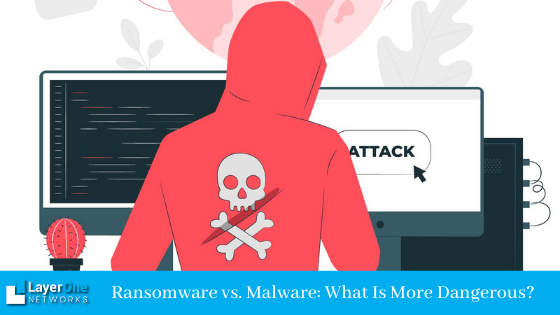At a time when businesses are under threat from cybersecurity issues, you can never be too cautious.
Online security threats are everywhere — from the emails we open to the WiFi networks we connect. And with businesses depending on online tools and communication, we need to be careful more than ever to prevent ourselves from attacks. This is why everyone needs to be aware of the different cyber threats and what it means for businesses.
Among the popular cyber issues, ransomware and malware are some of the most common ones used interchangeably.
In this blog, our security experts from our IT consulting firm shed light on the differences between ransomware and malware and analyze which of these is the most dangerous.
What Is Malware?
Malware is software or a tool that has malicious intentions—many of the current cybersecurity hacks and threats we find come under the category of malware.
Usually, the hacker tricks you into installing this malware on your system by clicking on a trustworthy link or gaining access to your login details. Once this malware is installed, it can monitor all the actions you do on the system, record, and send it to another server accessible by the hacker.
The typical examples of malware are viruses, worms, spyware, adware, crypto-jacking, and spambots. Every malware is designed to do a specific job as needed by the hacker.
What Is Ransomware?
Ransomware is a type of malware that gets access to a system and asks for a ransom in exchange for giving access. Usually, the ransomware software gets installed on a system with phishing attacks.
A ransomware software can access the credentials, files, share them to another location, set up a ransom, and demand payment. One of the main issues with ransomware is that the hacker threatens to leak confidential information if the ransom isn’t paid.
Which Is More Dangerous: Ransomware or Malware?

First of all, we need to understand that there are certain degrees of danger to either form of hacking based on the security and the sensitiveness of the accessed files. To understand which can do more harm, we need to know how different they are.
Basic Working
Before we consider how malware and ransomware are different, let’s first understand how much they differ in the way of operations.
Most malware will try to replicate the files on the system and share them with the hacker. It also copies itself from file to file, corrupting the files in the process and gaining access to the information.
Ransomware is entirely different. Once ransomware gets installed, it prevents access to the system using high-security features. The ransomware will be removed after the payment is fulfilled.
Level of Access
Let’s consider the amount of access both of these cyberthreats have. In the case of malware, while it can access information up to a level and even slow down the system’s performance, it cannot destroy a business.
On the other hand, we have seen several actual companies shutting down after being attacked by ransomware. So, in terms of access and impact, ransomware is more threatening than most other malware.
Method of Protection and Removal
Protecting your systems against different types of malware, including ransomware, is done by installing anti-virus and anti-malware protection solutions. The company employees who have access to sensitive information should avoid clicking on suspicious links and becoming victims of phishing attacks.
While the protection for both ransomware and malware is similar, the ease with which we remove this malware once it gains access to a system is different. While we can try to remove other types of malware by using software, it’s hard to do the same with ransomware. Only when the payment is fulfilled can the ransomware be removed.
Identification
When a system is infected with malware, it can be hard to identify it. The malware doesn’t make itself known, and you can only detect it using the anti-virus programs and suspect when your system’s performance is slowing down. If it’s mild malware, you can reconfigure the operating system to get rid of it. Or, you can implement a disaster recovery program to salvage some of the damage.
However, in the case of ransomware, the ransomware will make itself known soon after it has infected a system by blocking your access. So there’s very little you can do when the damage is already done other than to pay up.
When we compare these different levels of impacts of both malware and ransomware, we see that ransomware can do more damage than ransomware since ransomware is almost always brutal.
How Can You Protect Yourself from Malware and Ransomware?
If you’re wondering how you can prevent any cybersecurity issue from happening, then you need to be critical of the protection programs you have in place. Apart from using software and tools to run regular security checks, it would help if you got a good data security team to help you increase security.
Layer One Networks is an experienced IT consulting firm offering security services for businesses in Corpus Christi. With our security IT services, we help businesses increase their protection from such malicious software and keep their information safe. If you’re looking for an experienced team to help you out, then reach out to us now.

